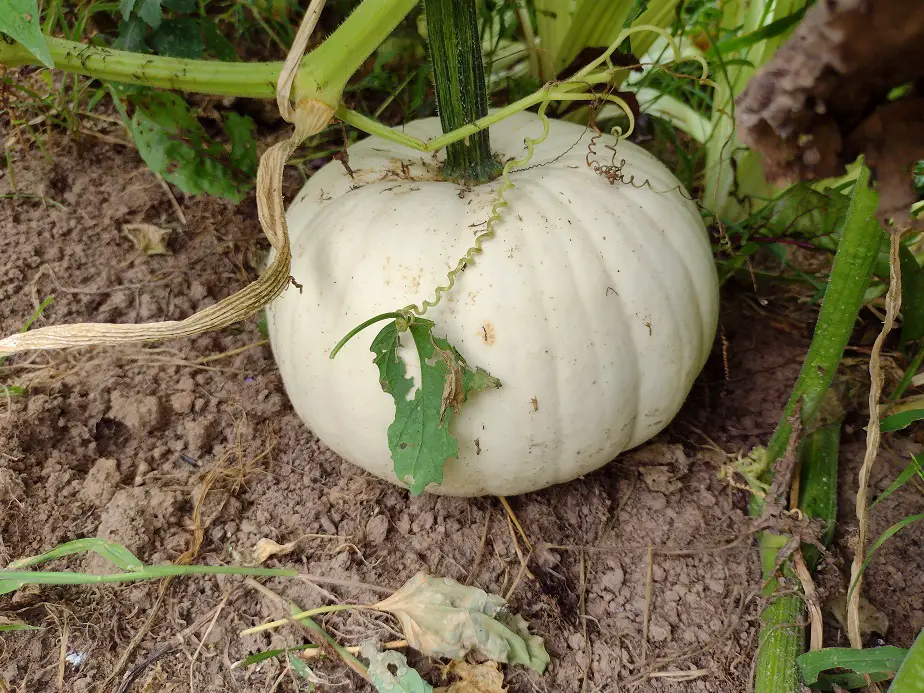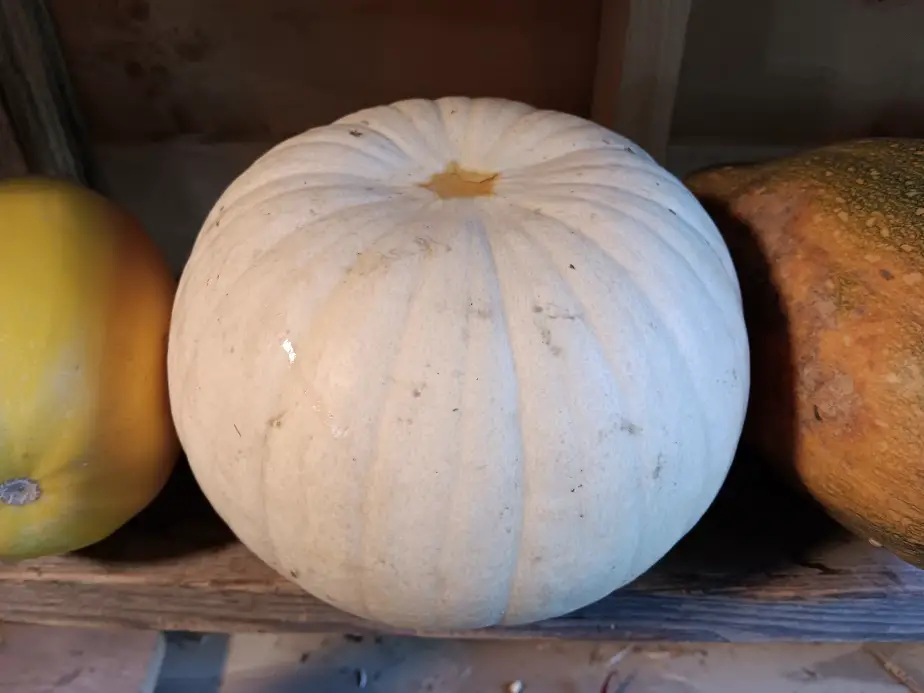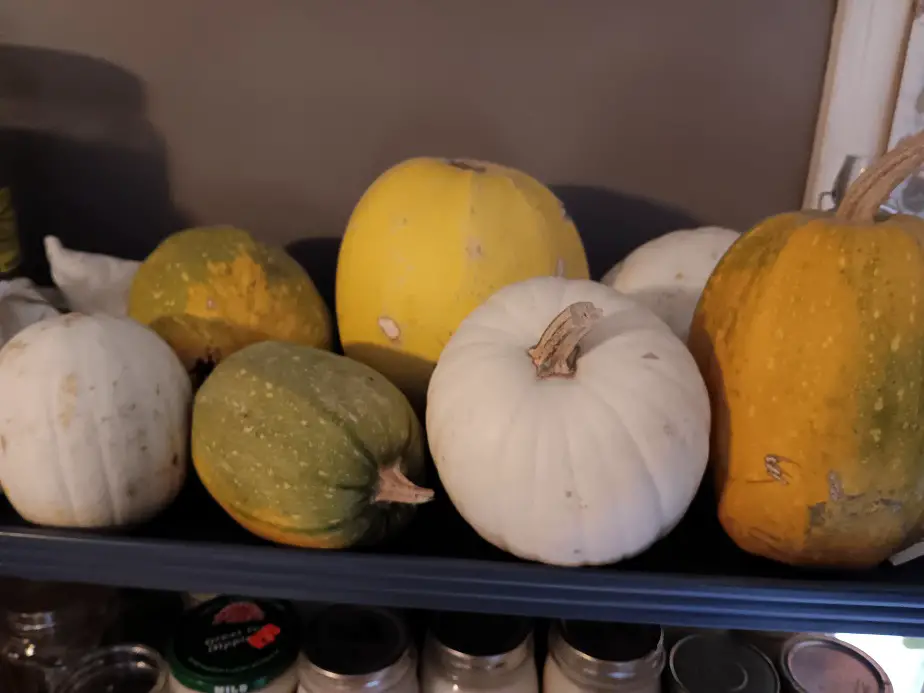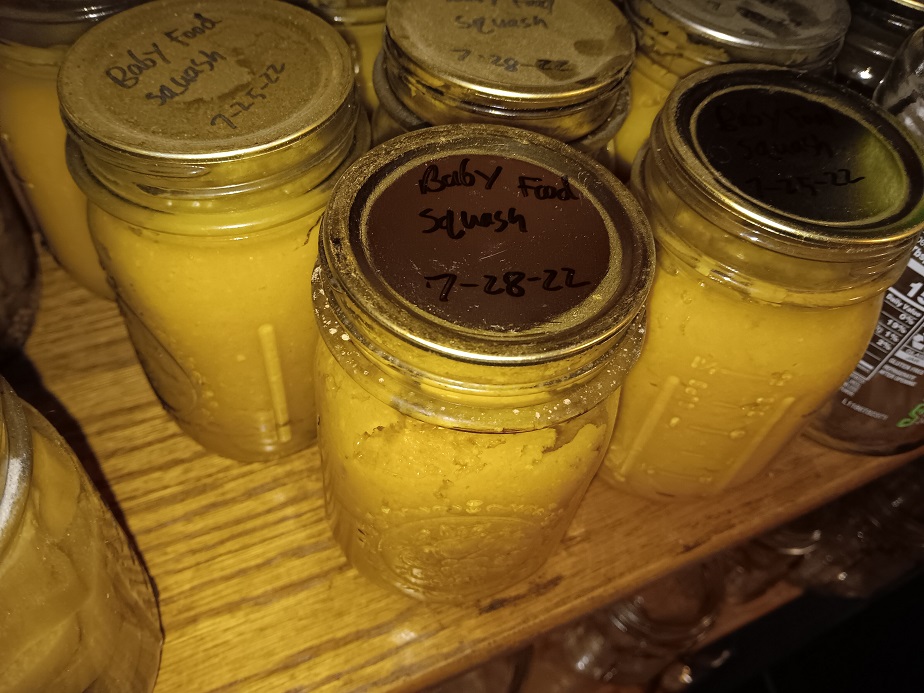Pumpkins are an old American Indian survival crop. They usually last in storage for five months. Here’s how we store them all winter.
Pumpkins store best in a cool, humid environment. They store best between 60 and 40 degrees F and at 50 to 60 percent humidity. In these conditions, pumpkins can last six months or more if they have strong, clean skin without major blemishes. Keep them from touching damp surfaces.
Let’s talk about storing pumpkins.

How to Store Your Pumpkins Through Winter
I have squashes and pumpkins sitting on shelves in my living room, in my pantry, and in my shed. It’s January 2 and 24 degrees F outside. We picked the last of them around the end of September, 3 months ago. We will have fresh pumpkins for cooking for a good while.
When storing pumpkins, it’s most important to have 2 things. Firstly, it’s really helpful of the pumpkins are cured. That just means they have been picked, the stem healed, and the skin allowed to harden. If you pick the fruit while the vine is still green, you need to let it cure. It’s usually done by leaving it out in a dry spot of your field or garden for a week or two after you cut it from the vine.
The heat, dryness, and stress causes the fruit to develop a mature skin. It gets thicker and harder. That’s an important part of making your pumpkins and squashes storage-ready.
The second important thing is to have a place where they’re not going to be justled around in storage. So mainly, keep them out of the way of young children who have to fiddle with everything within reach. Squashes (pumpkins are just a round squash) will last longer if not handled or jostled much.

Best Temperature and Humidity for Storing Pumpkins
We store our pumpkins at room temperature or a little cooler. Pumpkins can be stored at higher temperatures than most produce because their skin won’t easily dry out. When temperatures go below 40 F, the chance of mold growth is significantly increased. If the temperature drops into the freezing zone, they tend to have a much shorter storage life.
Not all varieties of pumpkins go bad after freezing, but it does weaken the skin and tends to cause wounds that will lead to rot. I have a variety I’ve been developing for a few years that just so happens to withstand freezing temperatures better than any I’ve seen. I didn’t try for that trait, but I’ll take it.
I’ll go anywhere from 60 to 40 degrees if I have any say in the matter. If it’s colder you get more mold and if it’s warmer the fruits tend to dry out and get wrinkly and spongy. While that doesn’t affect the flavor much, it does increase the chances of rot.
A higher-humidity environment helps them not dry out. Here in Michigan, most houses are fairly humid. My home runs around 50 to 55 percent humidity indoors. That’s considered perfect for pumpkins. Much more humid and you can get condensation on the friuts. Much dryer will cause drying and shrinkage to the friuts after a while.

Which Varieties of Pumpkin Store the Best?
Pumpkins are not an actual variety of species of plant. They are a menagerie of any fairly well-rounded squash. Traditionally, they could be any color as long as they were quite round. The traditional, early American pumpkins were green, orange, or white and considered small or moderately sized.
They can be one of about four or five varieties of squash, but not all of them are quite so good at keeping in storage. The worst-keeping pumpkins are from the variety known as Cucurbita Pepo. They are usually smaller, very round, and often are common varieties of pie pumpkins. That variety just tends to have a more delicate skin and are usually bred for sweetness above other traits.
The squash I’ve deen developing is actually a Pepo, but it stores very well. Hopefully, It’ll end up going somewhere. That’d be nice. They’re 4 months after picking right now and are the only variety of Pepo I have that hasn’t gone bad in storage.
The best variety of common pumpkin for lasting storage is generally the Cucurbita Maxima. These are generally larger and denser, and have thicker, harder rinds which both prevent damage and keep out harmfull microbes. They also tend to have a thicker layer of natural wax which further increases shelf-life.
One lesser common variety that’s arguably the best for storing is the Malabar Squash. It’s properly known as Cucurbita Ficifolia. These are different from the common squashes and pumpkins of the US. They are great-tasting, just quite different. They’re almost more of a melon.
How to Freeze a Pumpkin
My wife always freezes some of our pumpkins. I’t just so easy, why not? We usually freeze a puree because it’s very hard to preserve that with home canning. Here’s how we do it.
Half the pumpkin, scrape out the innards, and cut it small enough to fit on a baking sheet. Place it on the sheet skin side up and bake at 350 degrees until you can poke a fork through it easily. You can also cook it in a pressure cooker, it goes really fast in one of those. After cooling, scrape out the soft inside and mash or blend it, put it in freezer bags, then freeze them. We don’t season it before freezing so that it can be used for any recipe when we get it back out.

My wife also canns a lot of pumpkin. She uses both the pressure canning and water-bath caning methods for cubed and shreded pumpkin. I’ll have to write about that some time. We don’t always abide by the USDA recomendations becaues as they say in their National Center for Home Food Preservtion guidelines, “We have no properly researched directions to recommend…”
Fortunately, other people and orginizations do. There are individuals, companies, and governmantal boddies across the world that have researched and do reccomend other methods and practices for home canning.
Related Articles:

